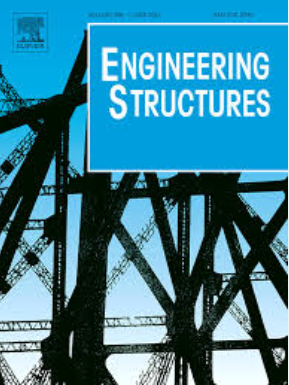CLT墙体与纯张拉支撑框架协同侧阻力试验研究
IF 6.4
1区 工程技术
Q1 ENGINEERING, CIVIL
引用次数: 0
摘要
为了提高胶合层框架结构的横向性能,提出了一种钢-木混合结构,其特点是CLT墙体和纯张拉支撑的协同抗侧阻力。对两种由CLT墙体和纯张拉支撑框架组成的复合框架进行了低周反向加载试验,以研究这些组件之间的协同侧阻力机制。试验结果表明:复合框架构件的破坏始于单纯抗拉支撑的抗拉屈服、胶合木柱端部的开裂,随后是CLT墙体的抗拉连接的破坏。纯张拉支撑主要在框架弹性阶段发挥作用,提供不低于70 %的侧阻力,而CLT墙体在框架弹塑性阶段更为关键,贡献超过55 %的侧阻力。本文章由计算机程序翻译,如有差异,请以英文原文为准。
Experimental study on the synergistic lateral resistance of CLT walls and tension-only braced frames
To enhance the lateral performance of glulam frame structures, a beam-through steel-timber hybrid structure is proposed, featured by the synergistic lateral resistance of CLT walls and tension-only braces. Low-cycle reversed loading tests were conducted on two composite frames consisting of the CLT wall and tension-only braced frame to investigate the synergistic lateral resistance mechanism between these components. The test results indicated that the failure of the components of the composite frame started with the tensile yielding of the tension-only bracing, the cracking at the ends of the glulam columns, and followed by failure of the CLT wall's hold-down connections. The tension-only bracing was mainly active during the elastic stage of the composite frame, providing no less than 70 % of the lateral resistance, while the CLT wall became more critical in the elastic-plastic stage of the composite frame, contributing more than 55 % of the lateral resistance.
求助全文
通过发布文献求助,成功后即可免费获取论文全文。
去求助
来源期刊

Engineering Structures
工程技术-工程:土木
CiteScore
10.20
自引率
14.50%
发文量
1385
审稿时长
67 days
期刊介绍:
Engineering Structures provides a forum for a broad blend of scientific and technical papers to reflect the evolving needs of the structural engineering and structural mechanics communities. Particularly welcome are contributions dealing with applications of structural engineering and mechanics principles in all areas of technology. The journal aspires to a broad and integrated coverage of the effects of dynamic loadings and of the modelling techniques whereby the structural response to these loadings may be computed.
The scope of Engineering Structures encompasses, but is not restricted to, the following areas: infrastructure engineering; earthquake engineering; structure-fluid-soil interaction; wind engineering; fire engineering; blast engineering; structural reliability/stability; life assessment/integrity; structural health monitoring; multi-hazard engineering; structural dynamics; optimization; expert systems; experimental modelling; performance-based design; multiscale analysis; value engineering.
Topics of interest include: tall buildings; innovative structures; environmentally responsive structures; bridges; stadiums; commercial and public buildings; transmission towers; television and telecommunication masts; foldable structures; cooling towers; plates and shells; suspension structures; protective structures; smart structures; nuclear reactors; dams; pressure vessels; pipelines; tunnels.
Engineering Structures also publishes review articles, short communications and discussions, book reviews, and a diary on international events related to any aspect of structural engineering.
 求助内容:
求助内容: 应助结果提醒方式:
应助结果提醒方式:


